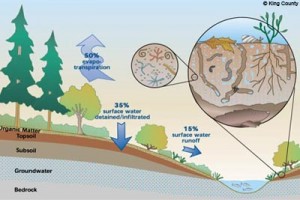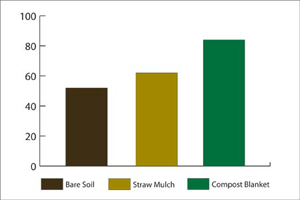Filtrexx University
The Stormwater Challenge
In the past decade there has been an increase in the use of organics for environmental applications, driven by engineers and progressive designers who want to restore the Earth’s natural capital. To understand the potential of these applications, one must first understand how Nature handles rainfall. This section focuses on Nature’s hydrologic cycle and the basic science behind Filtrexx® products—the ability of compost to retain stormwater, filter sediment and pollutants, and establish vegetation.

Introduction to Hydrology
Learn how nature uses principles of containment, filtration, retention, detention, energy dissipation, and vegetation establishment to provide valuable ecosystem services.

Compost Rainfall Absorption
(4”/hr 1-hr; 100 yr return)
Compost applied to the soil surface acts as a tremendous natural sponge, absorbing large amounts of rainfall, thereby reducing storm water runoff. This is one of the principal ways in which compost blankets are effective in reducing soil erosion and transport of sediment and other pollutants. This lesson highlights several studies showing consistent data on the ability of compost to reduce stormwater volume.

The Soil & Water Connection
The US Composting Council Research and Education Foundation (CCREF) has consolidated the growing body of research supporting the effectiveness of compost to mitigate storm water by managing rain where it falls, thereby preventing the transport of sediment and harmful pollutants to our nation’s waterways. The guide, in its second edition, outlines science-based best management practices to water, soil and forestry managers.

